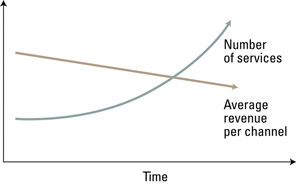Is channel-in-a-box ready for prime time?

Figure 1. Revenue per channel is falling as services increase.
Tremendous industry change over the past few years has led to a channel explosion, as well as terrestrial, satellite and mobile delivery of any content, anywhere, anytime. However, while the number of content delivery services and platforms increases, audiences and available revenues remain fairly flat. This equation amounts to on average fewer Euros earned per service and, thus, less money with which to run those services. (See Figure 1.)
Working within this cost-driven environment, broadcasters are looking for affordable playout solutions that will integrate easily into their existing workflows. They need solutions that will allow them to reduce the cost and complexity of their playout systems while maintaining performance and reliability in critical operations. This doesn’t refer to only disaster recovery or secondary revenue-generation services, but also prime-time channels on which brand identities and primary revenues depend.
Given the coincident evolution of IT-based broadcast technology and high demand for more economical channel playout solutions, the industry has begun migrating playout to the channel-in-a-box model. While channel-in-a-box systems aren’t literally single-box solutions, what they do provide are the core functions of a channel integrated in a software/IT platform. This allows them to reduce their cost of ownership and save money while producing more channels and services — ultimately, realizing a greater ROI.
Implementing a channel-in-a-box system is fundamentally about lowering costs and not just the cost of purchase or capital expenditures (though, clearly, the savings in those areas are significant). With this technology, the actual cost of deployment is much lower than that of traditional approaches because there are fewer systems to integrate and fewer components used. As a result, less wiring and rack space is required, less power and cooling needed, and less overall support and maintenance required. Improved reliability is realized as a result of fewer interconnecting systems and fewer points of failure, which means that channel-in-a-box systems ultimately yield better results in terms of on-air performance. As business and operational needs change, the channel-in-a-box model simplifies the upgrade process.
It is true that across the broadcast industry, there has been some reticence to trust a relatively new technology with high-revenue services. And, for some time, large sectors of the broadcast community sat on the fence and watched other companies’ experiences with the technology before they themselves made the commitment.
Those companies that first cautiously adopted channel-in-a-box solutions, proving the technology in secondary revenue-generation services or for disaster recovery applications, now have gained confidence to employ them across their operations. And now, even the largest players in our industry are delivering complex, high-value channels with channel-in-a-box systems. Proving the concept internally, such companies have recorded on-air reliability figures exceeding those they achieved using traditional systems built on discrete components.
The professional video industry's #1 source for news, trends and product and tech information. Sign up below.
From concept to reality
As with many advances in the broadcast industry, the emergence of the channel-in-a-box engendered much hype without the same degree of understanding when it came to the technology’s true application and commercial realities of implementing it. Furthermore, while IT-based playout had become possible, many of the critical functions — for example, multi-channel audio processing, ancillary data management and captioning — were absent in early products.
It has taken some time for serious channel-in-a-box products to evolve to the point that they truly can support a complex broadcast channel, but solutions available today offer a cost-effective, reliable and scalable means of distributing anything from a single SD channel to multiple HD channels. The well-established reliability and refined feature sets of today’s channel-in-a-box systems are resulting in deployment for all types of playout services.
Deployment for prime-time and premium services really has been about reaching a critical mass with respect to channel-in-a-box functionality. At recent trade shows, attendees have been exposed to a plethora of channel-in-a-box and IT-based playout systems by other names. However, to support playout of a prime-time channel, the channel-in-a-box system must demonstrate a level of functionality well beyond that of early models, which were little more than video servers equipped with some branding and graphics capabilities. The complex requirements of broadcast channels mean that a true channel-in-a-box solution must have a much richer feature set in order to accommodate these requirements.
Channel-in-a-box systems really had to mature to reach that baseline of capability for a prime-time channel to go on-air. There was no single function that put single-box systems over that line. Rather, it was an incorporation of a host of functions, all essential to delivery of today’s sophisticated broadcast channels.
Getting fit for prime time
The ongoing challenge in developing channel-in-a-box solutions has been getting more of the broadcast chain into a single environment. A further challenge has been handling the richness of modern broadcasts and maintaining a complete and full feature set that successfully addresses an evolving industry.

Figure 2. Channel-in-a-box functions must mimic those of a traditional playout infrastructure, which is shown here.
As with any other functions in a channel-in-a-box solution, switching and branding functions must mimic the historic functionality to which broadcasters are accustomed. (See Figure 2.) From the control and operations perspective, these functions must offer the same technology and power. Though a different type of enabling technology is bringing new cost benefits, this difference is abstracted from the user, whose experience of key functions, such as switching and branding, remains very much the same as with traditional systems.
On top of switching and branding, the advanced system functionality that today makes the channel-in-a-box system fit for prime time includes format-agnostic processing of SD and HD material, along with the ability to manage those processes required to prepare pictures, sound and ancillary data for secure, frame-accurate, high-quality SD/HD playout. Integrated format conversion for up/downconversion and aspect ratio conversion is key to handling multiformat material from varied sources smoothly, on a single timeline and in a single playlist.
Routing and mixing capabilities within channel-in-a-box give broadcasters the tools to handle multiple layers and sources with ease and to add transitions seamlessly. Advanced 3-D graphics, DVEs and keyers add further visual sophistication to the output, allowing broadcasters to give a channel a dynamic, cutting-edge look and feel.
Audio processing functions such as voiceover input support and mixing into the output with program level adjustment ensures top-quality results. Ancillary data support — in particular, subtitling and closed-caption support for SD and HD — reduces the amount of external equipment required to deal with legacy content while ensuring correct insertion of HD captions.
The addition of high-performance SAN storage to channel-in-a-box solutions has aided in optimizing media distribution workflows, as well as overall playout system performance. By reducing the need for media transfers, shared storage eliminates common bottlenecks and facilitates simultaneous playback and recording of files by multiple channel-in-a-box systems.
Dynamic resource assignment in channel-in-a-box systems has dramatically increased their flexibility in single and multichannel environments, allowing broadcasters to configure the signal path for any presentation style, both now and in the future. In terms of playout reliability, the usual requirements apply now to channel-in-a-box systems, some of which feature RAID storage, dual redundant power supplies, dual redundant mirrored playback, guard sources and multi-site and multi-system synchronized redundancy. For prime time, the channel-in-a-box needs comprehensive facilities to equal the features of traditional systems. Some feature multi-system synchronized redundancy. (See Figure 3.)

Figure 3. For prime-time applications, the channel-in-a-box needs comprehensive facilities to equal the features of traditional systems. Some, like this one, feature multi-system synchronized redundancy.
Over the years, channel-in-a-box solutions have become more sophisticated in supporting both full channel playout as well as ancillary services. Still, there remains quite a spectrum of capability in this space, and not all systems are equal. “Channel-in-a-box” is a widely used term applied to both the most basic solutions and to the complex solutions that today integrate fully into broadcast systems.
Ensuring compatibility and versatility
While integration for channel-in-a-box solutions can be a challenge, it really is no more of an obstacle than is integration for traditional products. In either case, one significant challenge is ensuring file-format compatibility. With the proliferation of systems that generate files, broadcasters are finding that there can be very subtle incompatibilities in file formats. In some cases, files created on traditional systems or in traditional environments present compatibility issues when the broadcaster goes to play them out with a channel-in-a-box system.
Good integration is one important step in addressing the file-format compatibility problem. Another important step is the pre-validation of source material by the system prior to playout. Thus, bad files can be quarantined before they can go to air, and operators are alerted to any problems found so that they can be resolved well before material is required for transmission.
Smart interfaces with upstream media management systems and the support of a robust automation system bring greater sophistication to the channel-in-a-box system, giving it the versatility to address all the nuances and idiosyncrasies of premium-channel playout. The single-box solution does simplify the broadcast infrastructure, but broadcasting itself is as complex as it has ever been. For that reason, successful channel-in-a-box solutions focus on all that comprises a TV channel, fitting as much of this functionality into the software domain and putting it into the “box.”
The evolution of the IT platform has made it possible to fit an enormous amount of functionality in current channel-in-a-box systems, which, in turn, meets the demands of premium and prime-time channels. Indeed, it is now becoming a given that playout will be IT-based. The question of when has been asked and answered. And though some of the most popular channels on-air today already run on channel-in-a-box technology, viewers (and sometimes even competing networks) are none the wiser.
—Neil Maycock is chief architect at Snell.
